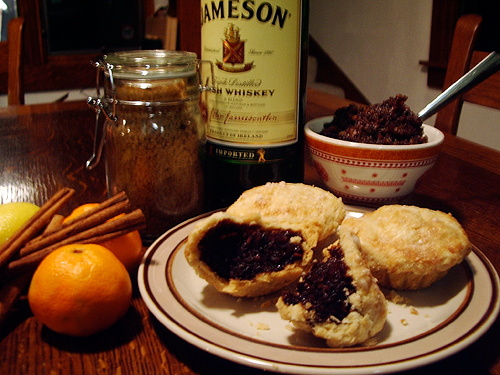But now that the indulgence of the holidays has passed, mincemeat might be a tougher sell. Enter Black Tart, a lovely winter dessert based on a 17th-century recipe for "black tart stuff," which the eminent British food writer Elizabeth David praises in An Omelette and a Glass of Wine as "rich and dark without the cloying and heavy qualities of mincemeat." She also recommends it as having "a certain originality which provides a small surprise at the end of the meal."
Leafing through cookbooks heaped from shelves to floor, I can trace the roots of my own Black Tart to several recipes: David's 1969 recipe, itself a modern interpretation of Robert May's recipe from The Accomplisht Cook (1660); the Harvest Tart from the The Silver Palate Cookbook (1982); and the Winter Fruit Tart from the Bay Wolf Restaurant Cookbook (2001).
Mostly, though, it came from messing around with the memories of all these things in a friend's kitchen on a raw, gray afternoon, when we both wanted something sweet to eat without having to leave the house.
What was on hand in the winter pantry? Dried fruit and nuts, candied fruit peel left over from holiday baking, and plenty of liquor, likewise left over from holiday parties. Thus, Black Tart, a lazy-day sort of dessert that will warm the kitchen and perfume the house with a deep medieval scent of winter at bay--a whiff of whiskey, a breath of ginger and cinnamon, a Mediterranean sparkle of fresh tangerine.
The dried fruits aren't poached so much as steeped. After a slow warming, they sit on the back of the stove for an hour or so, soaking up the wine and spices, swelling up soft and plump as they absorb nearly all the liquid.
A cookie-like tart dough, a little sweeter and richer than regular pie crust, works particularly well here. To make it, sift together two and a half cups of flour, a quarter cup sugar, and a half-teaspoon salt. Using a pastry blender, cut in 12 tablespoons (one and a half sticks, 6 oz) of chilled butter, until mixture looks sandy and flaky, like dry oatmeal. Then, instead of the usual ice water, moisten the flour with two egg yolks, one teaspoon vanilla, and three to four teaspoons of water to form a soft dough. Chill for several hours while the filling is cooking and cooling.
Black Tart
This tastes best on the day it's made, but will last for several days if well wrapped. The recipe can also be used to made small individual-sized tarts. For the prettiest crust on small tarts, brush tart crust with milk and sprinkle with sugar before baking.
Ingredients
1 large apple, peeled, cored, and diced
1 cup dried apricots, chopped
1 cup pitted prunes, chopped
1/2 cup raisins
2-3 tbsp candied orange peel
1 cup red wine OR 1/2 cup port and 1/2 cup water
1/4 cup whiskey or brandy
1/8 tsp EACH cinnamon, cardamon, nutmeg, and ginger
Big pinch of freshly ground pepper
1/2 cup brown sugar
1/2 cup white sugar, or to taste
Zest and juice of 1 tangerine
1/2 cup toasted walnuts or almonds, chopped
Dough for two-crust tart (see above)
Whipped cream for serving
Preparation
1. In a heavy-bottomed pot, mix all filling ingredients except for walnuts. Warm over low heat, stirring occasionally, for 15 minutes. Turn off heat and let fruit absorb the rest of the liquid for an hour or so.
2. Divide the tart dough into two rounds and roll out. Line an 8-inch or 9-inch tart pan with first round.
3. Stir walnuts into filling. Cut remaining dough into 1-inch wide strips. Lay strips in a criss-cross lattice pattern to cover most of the filling. Cover entire tart with foil or waxed paper and chill in the fridge for an hour or so.
4. Preheat oven to 400 degrees F. Unwrap tart and bake until crust in golden brown and filling is bubbling, 30-35 minutes. Cool on a rack. Serve with whipped cream.
